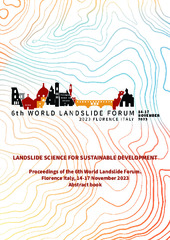Приказ основних података о документу
A landslide data base model for ClirTheRoads project in Serbia
| dc.contributor | Tofani, Veronica | |
| dc.contributor | Casagli, Nicola | |
| dc.creator | Abolmasov, Biljana | |
| dc.creator | Stanković, Ranka | |
| dc.creator | Vulović, Nikola | |
| dc.creator | Marjanović, Miloš | |
| dc.creator | Đurić, Uroš | |
| dc.date.accessioned | 2023-12-27T12:19:53Z | |
| dc.date.available | 2023-12-27T12:19:53Z | |
| dc.date.issued | 2023 | |
| dc.identifier.isbn | 9791221048063 | |
| dc.identifier.uri | https://grafar.grf.bg.ac.rs/handle/123456789/3356 | |
| dc.description.abstract | Within the project Mainstreaming Climate Resilience in the Road Transportation Management in Serbia (CliRtheRoads), a complex software solution was developed to support Public Enterprise Roads of Serbia in climate change adaptation planning and management. The software solution comprises 1) web portal for data entry and management for authorised users 2) publicly available web GIS part 3) mobile GIS application and 4) back-end database (Figure 1). In order to store and process the data collected during field visits and surveys, the data base developed in project first phase (Valjevo test area), was modified to include new datasets and to store new datatypes (as floods), and new modules (as activity cost) for Kraljevo test area. Both test areas have been chosen due theirs diversified characteristics, many climate related hazards, and the fact they suffered greatly from disasters recently (Abolmasov et al. 2017, Abolmasov et al. 2021). The database was upgraded to new model aimed for maintaining legacy data from both test areas, but also for future infrastructure resilience projects based on same approach, to enable that all data will be stored and mapped in a unified manner. The data model include 1) main concepts (entity types) for the instabilities, with detailed data comprising common and specific attributes, 2) storage of multimedia (mainly photo from field work, but possible video as well), 3) knowledge base with cost of activities, including catalogue per each entity type with job type and description, unit and total price, maintenance type (regular maintenance, rehabilitation, urgent maintenance), including recommending activities (system allow user to add specific activities, description and cost that is further calculated and aggregated with other data); 4) secondary data from other sources (other projects, legacy data and external resources), or from interpreted data. The data was stored in the PostgreSQL Database, a web application was developed (using PHP) to facilitate data input, maintain knowledge database and calculate cost of recommended activities. There is a total of 461 records with fully described instabilities (slides, falls, topples, flows), documented by large number of photographs from the field. Additionally, every record is supplemented by engineering solution to support field engineers or decision makers for better road management in climate changing conditions. | sr |
| dc.language.iso | en | sr |
| dc.publisher | OIC S.r.l., Viale della Giovine Italia, 17, 50122 Firenze, Italy | sr |
| dc.rights | openAccess | sr |
| dc.rights.uri | https://creativecommons.org/licenses/by-nc-nd/4.0/ | |
| dc.source | 6th World Landslide Forum, Florence, Italy, 14-17 November 2023, Abstract book | sr |
| dc.subject | landslide | sr |
| dc.subject | database | sr |
| dc.subject | rockfall | sr |
| dc.subject | geology | sr |
| dc.title | A landslide data base model for ClirTheRoads project in Serbia | sr |
| dc.type | conferenceObject | sr |
| dc.rights.license | BY-NC-ND | sr |
| dc.rights.holder | International Consortium on Landslides | sr |
| dc.identifier.fulltext | http://grafar.grf.bg.ac.rs/bitstream/id/12562/bitstream_12562.pdf | |
| dc.identifier.rcub | https://hdl.handle.net/21.15107/rcub_grafar_3356 | |
| dc.type.version | publishedVersion | sr |

